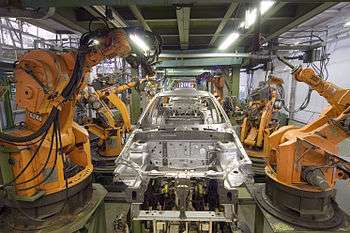Fourth Industrial Revolution
The Fourth Industrial Revolution (4IR) is the fourth major industrial era since the initial Industrial Revolution of the 18th century. It is characterized by a fusion of technologies that is blurring the lines between the physical, digital, and biological spheres, collectively referred to as cyber-physical systems.[1] It is marked by emerging technology breakthroughs in a number of fields, including robotics, artificial intelligence, nanotechnology, quantum computing, biotechnology, the Internet of Things, the Industrial Internet of Things (IIoT), fifth-generation wireless technologies (5G), additive manufacturing/3D printing and fully autonomous vehicles. Klaus Schwab, the executive chairman of the World Economic Forum, has associated it with the "second machine age"[2] in terms of the effects of digitization and artificial intelligence (AI) on the global economy, but added a broader role for advances in biological technologies.[3] These technologies are disrupting almost every industry in every country. And the breadth and depth of these changes herald the transformation of entire systems of production, management, and governance.
Schwab sees as part of this revolution "emerging technology breakthroughs" in fields such as artificial intelligence, robotics, the Internet of Things, autonomous vehicles, 3D printing, quantum computing and nanotechnology.[4] The fourth wave of the industrial revolution is expected to see the heavy implementation of several emerging technologies with a high potential of disruptive effects. [5]
Stages of the Industrial Revolution
First Industrial Revolution
The First Industrial Revolution took place from the 18th to 19th centuries in Europe and America. It was a period when mostly agrarian, rural societies became industrial and urban.[6] The iron and textile industries, along with the development of the steam engine, played central roles in the Industrial Revolution.[6]
Second Industrial Revolution
The Second Industrial Revolution took place between 1870 and 1914, just before World War I.[7] It was a period of growth for pre-existing industries and expansion of new ones, such as steel, oil and electricity, and used electric power to create mass production. Major technological advances during this period included the telephone, light bulb, phonograph and the internal combustion engine.[8]
Third Industrial Revolution
The Third Industrial Revolution, or the Digital Revolution, refers to the advancement of technology from analog electronic and mechanical devices to the digital technology available today. The era started during the 1980s and is ongoing.[9] Advancements during the Third Industrial Revolution include the personal computer, the internet, and information and communications technology (ICT)
Fourth Industrial Revolution

The Fourth Industrial Revolution builds on the Digital Revolution, representing new ways in which technology becomes embedded within societies and even the human body.[10] The Fourth Industrial Revolution is marked by emerging technology breakthroughs in a number of fields, including robotics, artificial intelligence, nanotechnology, quantum computing, biotechnology, The Internet of Things (IoT), 3D printing and autonomous vehicles.
In his book, The Fourth Industrial Revolution, professor Klaus Schwab, founder and executive chairman of the World Economic Forum, describes how this fourth revolution is fundamentally different from the previous three, which were characterized mainly by advances in technology. The underlying basis for 4IR lies in advances in communication and connectivity rather than technology. These technologies have great potential to continue to connect billions of more people to the web, drastically improve the efficiency of business and organizations and help regenerate the natural environment through better asset management.[11]
“Mastering the Fourth Industrial Revolution” was the theme of the World Economic Forum Annual Meeting 2016 in Davos-Klosters, Switzerland.
According to Arik Segal, the Fourth Industrial Revolution holds unique opportunities to improve human communication and conflict resolution.[12]
The phrase 'fourth industrial revolution' was first used in 2016, by World Economic Forum.[13]
See also
References
- ↑ "The Fourth Industrial Revolution: what it means and how to respond". World Economic Forum. Retrieved 2018-03-20.
- ↑
Compare:
Schwab, Klaus (2017) [2016]. The Fourth Industrial Revolution. New York: Crown Publishing Group. ISBN 9781524758875. Retrieved 2017-06-29.
Digital technologies [...] are not new, but in a break with the third industrial revolution, they are becoming more sophisticated and integrated and are, as a result, transforming societies and the global economy. This is the reason why Massachusetts Institute of Technology (MIT) professors Erik Brynjolfsson and Andrew McAfee have famously referred to this period as 'the second machine age,' [...] the title of their 2014 book [...].
- ↑ Schwab, Klaus (January 11, 2016). The Fourth Industrial Revolution. World Economic Forum. ISBN 1944835008.
- ↑
Compare:
Schwab, Klaus. "The Fourth Industrial Revolution: what it means, how to respond". World Economic Forum. Retrieved 2017-06-29.
The possibilities of billions of people connected by mobile devices, with unprecedented processing power, storage capacity, and access to knowledge, are unlimited. And these possibilities will be multiplied by emerging technology breakthroughs in fields such as artificial intelligence, robotics, the Internet of Things, autonomous vehicles, 3-D printing, nanotechnology, biotechnology, materials science, energy storage, and quantum computing.
- ↑ Ab Rahman, Airini; et al. (2017). "Emerging Technologies with Disruptive Effects: A Review" (PDF). PERINTIS eJournal. 7 (2). Retrieved 21 December 2017.
- 1 2 "Industrial Revolution". History Channel.
- ↑ "Second Industrial Revolution: The Technological Revolution - RVA". Richmond Vale Academy. 2016-07-21. Retrieved 2016-12-12.
- ↑ "The Second Industrial Revolution, 1870-1914 - US History Scene". US History Scene. Retrieved 2016-12-12.
- ↑ "What is the Digital Revolution? - Definition from Techopedia". Techopedia.com. Retrieved 2016-12-12.
- ↑ "What is the fourth industrial revolution?". World Economic Forum. Retrieved 2016-12-12.
- ↑ Marr, Bernard. "Why Everyone Must Get Ready For The 4th Industrial Revolution". Forbes (blog). Retrieved 2016-12-12.
- ↑ "Conflict Resolution in the Fourth Industrial Revolution". OpenMind. Retrieved 2018-02-14.
- ↑ "제4차 산업혁명" (in Korean). Retrieved 2018-03-24.